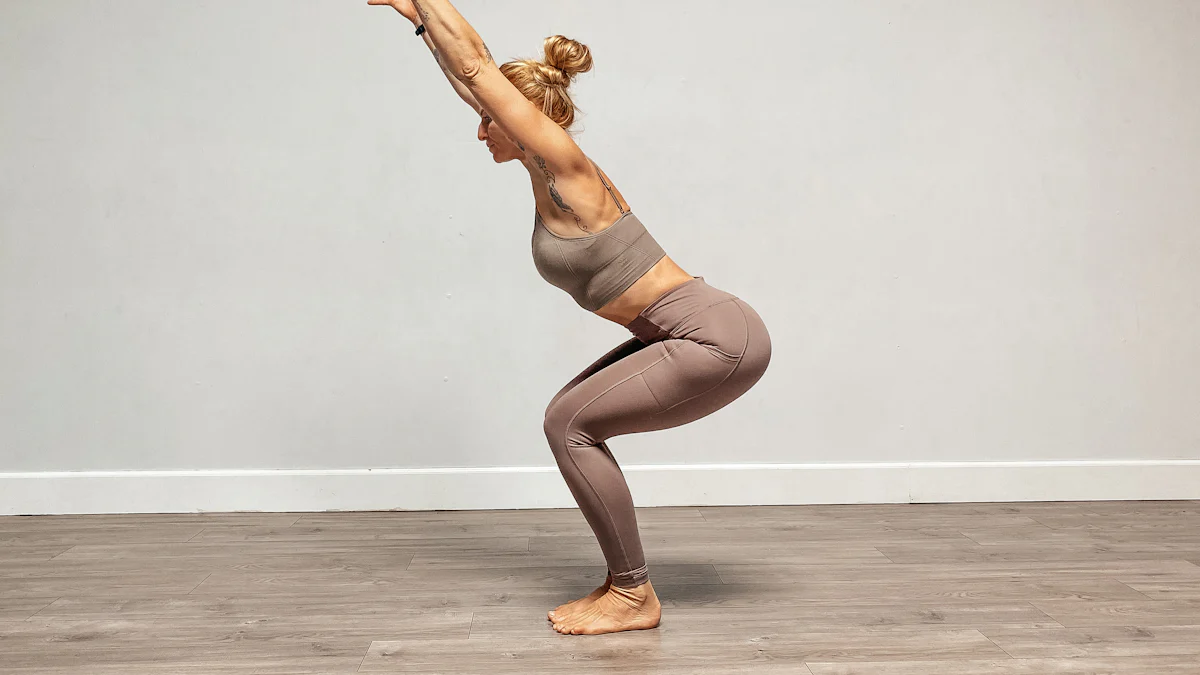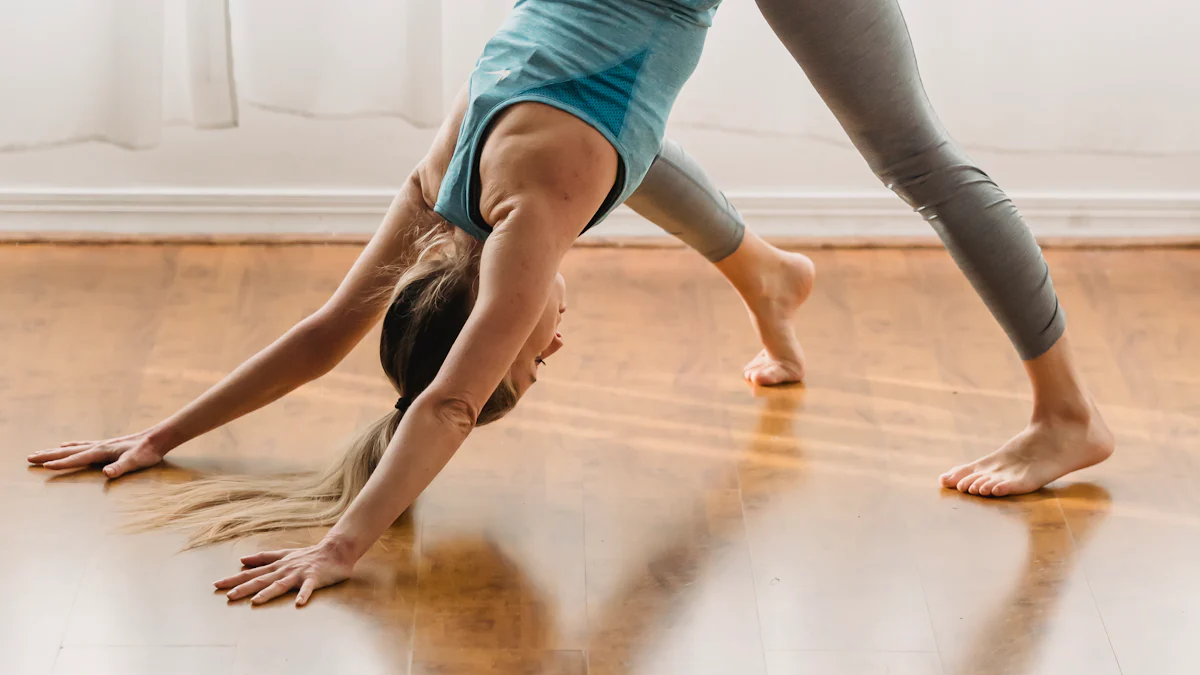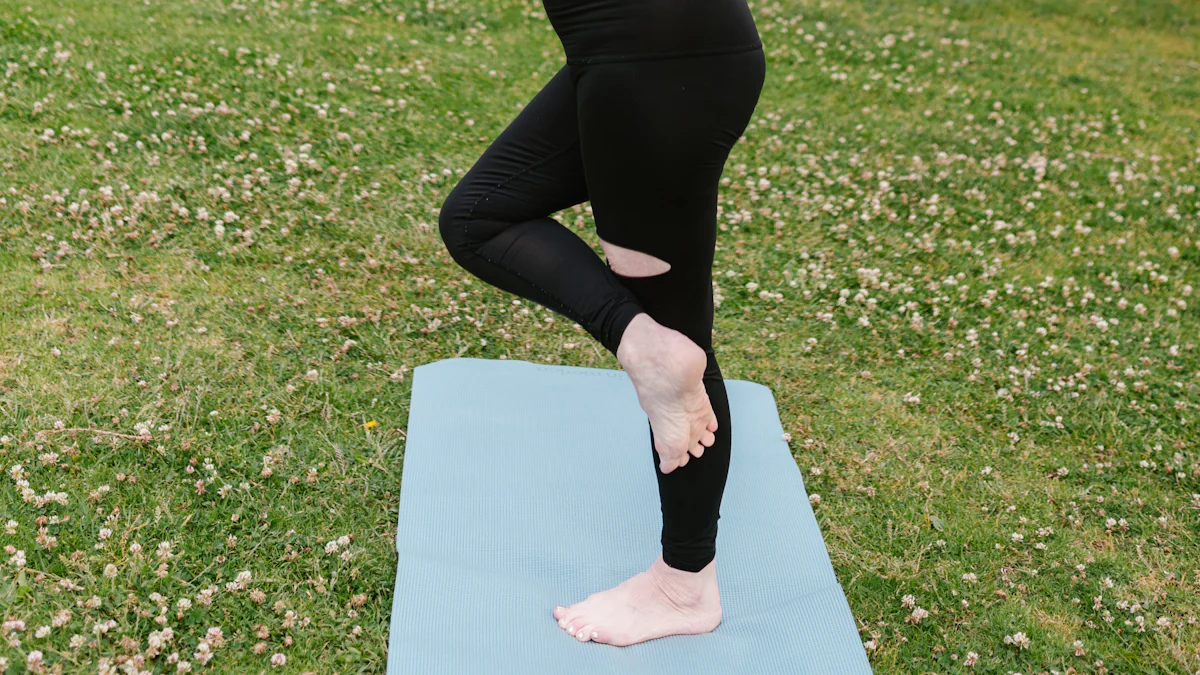 |
Yoga offers a wonderful way to enhance your physical and mental well-being. As a beginner, you might feel excited to explore this ancient practice. Starting with foundational yoga poses is crucial. These poses help you build strength, flexibility, and balance. Did you know that approximately 36 million Americans practice yoga regularly? Many beginners find relief from stress and improved mood through yoga. Embrace this journey, and you'll likely discover a positive shift in your life.
Mountain Pose (Tadasana)
Description
What is Mountain Pose?
Mountain Pose, or Tadasana, is one of the most fundamental yoga poses. It serves as the starting point for many other postures. You stand tall with your feet together, arms at your sides, and your weight evenly distributed. This pose might look simple, but it lays the groundwork for balance and alignment in your practice.
Importance of Mountain Pose in yoga practice
Mountain Pose plays a crucial role in yoga practice. It helps you develop awareness of your body and posture. By practicing Tadasana, you learn to engage your muscles and find your center. This awareness can enhance your overall yoga experience and improve your daily posture.
Benefits
Physical benefits
Mountain Pose offers several physical benefits. It helps improve your posture by aligning your spine and strengthening your legs. Studies suggest that Tadasana may reduce pain related to conditions like ankylosing spondylitis and soothe neck or back pain. Regular practice can also increase your flexibility and balance.
Mental benefits
Beyond the physical, Mountain Pose provides mental benefits. Standing tall in Tadasana can boost your self-esteem and confidence. A 2017 study found that standing yoga poses like Tadasana could lead to an improved sense of self-worth. This pose encourages mindfulness and focus, helping you feel more grounded and present.
Step-by-step Instructions
Initial stance
Stand with your feet together or slightly apart.
Distribute your weight evenly across both feet.
Keep your arms relaxed at your sides.
Alignment tips
Engage your thighs and lift your kneecaps.
Lengthen your spine and lift your chest.
Relax your shoulders away from your ears.
Breathing techniques
Inhale deeply through your nose, feeling your chest expand.
Exhale slowly, grounding yourself into the floor.
Maintain steady, rhythmic breathing throughout the pose.
Mountain Pose is more than just standing still. It's about finding your balance and connecting with your breath. As you explore this and other yoga poses, you'll discover how they can transform both your body and mind.
Downward Facing Dog (Adho Mukha Svanasana)
Description
What is Downward Facing Dog?
Downward Facing Dog, or Adho Mukha Svanasana, is one of the most iconic yoga poses. You might recognize it from countless yoga classes and images. This pose involves forming an inverted V-shape with your body, where your hands and feet press into the ground, and your hips lift toward the sky. It's a staple in many yoga sequences and serves as a transitional pose that connects various movements.
Role in yoga sequences
In yoga sequences, Downward Facing Dog acts as a bridge between poses. It provides a moment of rest while still engaging your muscles. Many yoga teachers use this pose to assess a student's alignment and flexibility. As a beginner, you'll find this pose frequently in classes, helping you transition smoothly from one posture to another.
Benefits
Physical benefits
Downward Facing Dog offers numerous physical benefits. It stretches your hamstrings, calves, and shoulders, promoting flexibility. This pose also strengthens your arms and legs, building endurance over time. Practicing this pose regularly can improve your overall posture and help alleviate back pain by elongating the spine.
Mental benefits
Beyond the physical advantages, Downward Facing Dog provides mental benefits too. As an inversion, it encourages blood flow to the brain, which can enhance focus and clarity. This pose also has a calming effect, helping to reduce stress and anxiety. By holding this position, you cultivate patience and mindfulness, grounding yourself in the present moment.
Step-by-step Instructions
Starting position
Begin on your hands and knees in a tabletop position.
Align your wrists under your shoulders and your knees under your hips.
Spread your fingers wide and press firmly into the mat.
Alignment tips
Tuck your toes under and lift your hips toward the ceiling.
Keep your knees slightly bent if your hamstrings feel tight.
Press your heels toward the floor, aiming for a straight line from your wrists to your hips.
Breathing techniques
Inhale deeply as you lift your hips and lengthen your spine.
Exhale slowly, pressing your chest toward your thighs.
Maintain steady, rhythmic breathing to stay focused and relaxed.
Downward Facing Dog is more than just a transition between yoga poses. It's a powerful tool for building strength and flexibility while calming your mind. As you practice this pose, you'll discover its ability to transform both your physical and mental state, enhancing your overall yoga experience.
Warrior I (Virabhadrasana I)
Description
What is Warrior I?
Warrior I, or Virabhadrasana I, is a powerful standing yoga pose that embodies strength and focus. You step one foot forward, bend the knee, and extend your arms overhead. This pose creates a strong foundation, helping you feel grounded and centered.
Significance in yoga practice
Warrior I holds a special place in yoga practice. It improves your standing poses and opens your hips, preparing you for more complex movements. By practicing Warrior I, you enhance your ability to twist the spine and open the shoulders, which is essential for backbends.
Benefits
Physical benefits
Warrior I builds full-body strength. It engages your legs, core, and arms, making it a comprehensive workout. This pose can be easily modified to suit all body types, even those with limited mobility. Regular practice enhances your balance and stability, crucial for other yoga poses.
Mental benefits
Beyond physical strength, Warrior I boosts mental focus. Holding this pose requires concentration, helping you develop mindfulness. As you engage with Warrior I, you cultivate a sense of determination and resilience, which can translate into everyday life.
Step-by-step Instructions
Initial stance
Stand tall with your feet hip-width apart.
Step your right foot forward, bending the knee.
Keep your left leg straight and strong.
Alignment tips
Align your right knee over your ankle.
Square your hips to face forward.
Reach your arms overhead, palms facing each other.
Breathing techniques
Inhale deeply as you lift your chest.
Exhale slowly, grounding through your back heel.
Maintain steady breaths to stay focused and calm.
Warrior I is more than just a pose; it's a journey into strength and mindfulness. As you explore this and other yoga poses, you'll find a deeper connection to your body and mind.
Tree Pose (Vrksasana)
Description
What is Tree Pose?
Tree Pose, or Vrksasana, is a classic yoga pose that embodies balance and grace. You stand on one leg while the other foot rests on the inner thigh or calf of the standing leg. Your arms reach upward, mimicking the branches of a tree. This pose challenges your stability and concentration, making it a staple in many yoga practices.
Importance for balance
Tree Pose plays a vital role in enhancing your balance. It requires focus and awareness, helping you connect with your body's center of gravity. Practicing this pose regularly can improve your overall stability, both on and off the mat. As one yoga practitioner shared, a stumble during Tree Pose made them realize its complexity and the importance of staying present. This awareness can transform your approach to yoga poses, encouraging mindfulness and intentionality.
Benefits
Physical benefits
Tree Pose offers numerous physical benefits. It strengthens your legs, ankles, and core, providing a solid foundation for other yoga poses. This pose also enhances your flexibility, particularly in the hips and groin. By practicing Tree Pose, you can improve your posture and alignment, which contributes to better overall body mechanics.
Mental benefits
Beyond the physical, Tree Pose provides significant mental benefits. It cultivates focus and concentration, requiring you to be fully present in the moment. This pose can also boost your confidence and self-esteem as you master the art of balance. One yoga teacher's advice during a challenging Tree Pose session changed a student's perspective, highlighting the pose's potential to foster personal growth and resilience.
Step-by-step Instructions
Starting position
Stand tall with your feet hip-width apart.
Shift your weight onto your left foot.
Bend your right knee and place the sole of your right foot on your inner left thigh or calf.
Alignment tips
Keep your hips level and facing forward.
Press your hands together in front of your chest or extend them overhead.
Engage your core to maintain stability.
Breathing techniques
Inhale deeply as you find your balance.
Exhale slowly, grounding through your standing foot.
Maintain steady, rhythmic breathing to stay focused and calm.
Tree Pose is more than just a balance exercise. It's an opportunity to connect with your inner strength and stability. As you explore this and other yoga poses, you'll discover how they can enhance both your physical and mental well-being.
Child's Pose (Balasana)
Description
What is Child's Pose?
Child's Pose, or Balasana, is a gentle yoga pose that invites you to rest and rejuvenate. You kneel on the floor, sit back on your heels, and stretch your arms forward. Your forehead touches the mat, creating a soothing and comforting position. This pose is often used as a resting posture during yoga sessions, allowing you to pause and reconnect with your breath.
Role in relaxation
Child's Pose plays a significant role in promoting relaxation. It encourages your body to shift into a state of rest and digest. By practicing this pose, you stimulate the vagus nerve, which helps lower stress levels and promotes a sense of calm. This simple yet effective posture can be a powerful tool for managing stress and anxiety.
Benefits
Physical benefits
Child's Pose offers several physical benefits. It gently stretches your back, hips, and thighs, providing relief from tension and tightness. This pose can also help reduce blood pressure and improve circulation. By incorporating Child's Pose into your routine, you support your body's natural ability to heal and restore itself.
Mental benefits
Beyond the physical advantages, Child's Pose provides mental benefits. It calms your nervous system and reduces cortisol levels, the hormone associated with stress. Practicing this pose regularly can enhance your mental well-being, promoting better sleep and reducing anxiety. As you rest in Child's Pose, you create space for mindfulness and introspection.
Step-by-step Instructions
Initial stance
Kneel on the floor with your big toes touching.
Sit back on your heels and separate your knees about hip-width apart.
Extend your arms forward, palms facing down.
Alignment tips
Allow your forehead to rest gently on the mat.
Relax your shoulders away from your ears.
Keep your hips close to your heels for a deeper stretch.
Breathing techniques
Inhale deeply, feeling your back expand.
Exhale slowly, releasing tension with each breath.
Maintain a steady, rhythmic breathing pattern to enhance relaxation.
Child's Pose is more than just a resting position. It's a sanctuary where you can find peace and tranquility. As you explore this and other yoga poses, you'll discover how they can transform your physical and mental state, enriching your overall yoga practice.
Cobra Pose (Bhujangasana)
Description
What is Cobra Pose?
Cobra Pose, or Bhujangasana, is a rejuvenating backbend that mimics the graceful rise of a cobra. You lie on your stomach and lift your chest, using your arms for support. This pose is a staple in many yoga practices, offering a gentle way to open the chest and strengthen the back.
Importance for back flexibility
Cobra Pose plays a vital role in enhancing back flexibility. By practicing this pose, you stretch the spine and improve its mobility. This flexibility can help alleviate tension and discomfort, making it an essential addition to your yoga routine.
Benefits
Physical benefits
Cobra Pose offers numerous physical benefits:
Strengthens the spine: Engages the muscles along your back, promoting strength and stability.
Opens the chest: Enhances lung capacity and improves breathing.
Stretches the shoulders and abdomen: Provides relief from tightness and tension.
Healthline Expert: "Doing the Cobra yoga pose every day may have several benefits, such as stretching and strengthening muscles."
Mental benefits
Beyond the physical, Cobra Pose uplifts the mind:
Boosts self-esteem: Encourages a sense of confidence and empowerment.
Reduces symptoms of depression: Promotes feelings of upliftment and elevation.
Healthline Expert: "Cobra Pose specifically has been associated with the 'feeling of upliftment and elevation.'"
Step-by-step Instructions
Starting position
Lie face down on your mat.
Place your hands under your shoulders.
Keep your legs extended and toes pointed.
Alignment tips
Press your feet and thighs firmly into the mat.
Lift your chest by straightening your arms.
Keep your elbows close to your body.
Breathing techniques
Inhale deeply as you lift your chest.
Exhale slowly, feeling the stretch in your back.
Maintain steady, rhythmic breathing to enhance relaxation.
Cobra Pose is more than just a stretch. It's a gateway to strength and serenity. As you incorporate this pose into your practice, you'll discover its power to transform both body and mind.
Seated Forward Bend (Paschimottanasana)
Description
What is Seated Forward Bend?
Seated Forward Bend, or Paschimottanasana, is a calming yoga pose that stretches your entire back. You sit with your legs extended and reach forward, aiming to touch your toes. This pose encourages a deep stretch, promoting relaxation and flexibility.
Role in flexibility
Seated Forward Bend plays a crucial role in enhancing flexibility. By practicing this pose, you stretch your spine, hamstrings, and calves. It helps improve your range of motion, making it easier to perform other yoga poses and daily activities.
Benefits
Physical benefits
Seated Forward Bend offers several physical benefits:
Improves flexibility: Stretches the spine and hamstrings.
Enhances digestion: Massages the abdominal organs.
Relieves tension: Eases tightness in the lower back.
Mental benefits
Beyond the physical, this pose provides mental benefits:
Promotes relaxation: Calms the mind and reduces stress.
Encourages mindfulness: Helps you focus on your breath and body.
Boosts mood: Creates a sense of peace and tranquility.
Step-by-step Instructions
Initial stance
Sit on the floor with your legs extended in front of you.
Flex your feet and keep your spine straight.
Inhale deeply, lengthening your torso.
Alignment tips
Reach forward with your hands, aiming to grasp your feet or ankles.
Keep your back straight as you fold forward.
Relax your shoulders away from your ears.
Breathing techniques
Inhale deeply, feeling your spine lengthen.
Exhale slowly, allowing your body to fold deeper.
Maintain steady, rhythmic breathing to enhance relaxation.
Seated Forward Bend is more than just a stretch. It's a journey into calmness and flexibility. As you practice this pose, you'll discover its ability to transform both your body and mind, enriching your yoga experience.
Starting your yoga journey with these essential poses sets a strong foundation. Each pose offers unique benefits, enhancing your physical and mental well-being. Regular practice promotes strength, flexibility, and a sense of calmness. You’ll find yourself more relaxed and focused. Remember to practice mindfully, listening to your body’s needs.
"Yoga has been shown to create a greater sense of well-being and improve self-confidence."
Explore further by joining classes or using online resources. Keep learning and growing in your practice. Embrace the journey, and enjoy the transformation yoga brings to your life.


